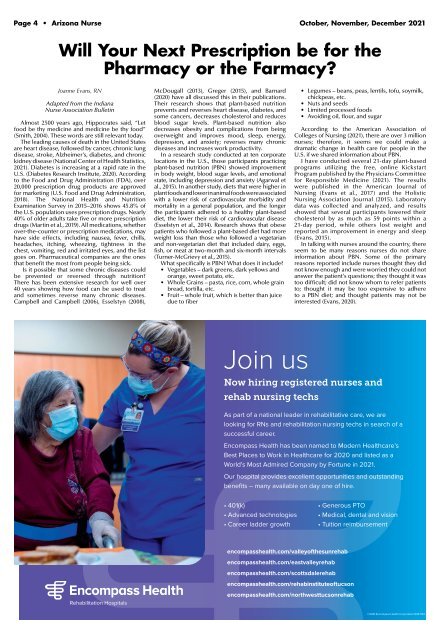Arizona Nurse - October 2021
Create successful ePaper yourself
Turn your PDF publications into a flip-book with our unique Google optimized e-Paper software.
Page 4 • <strong>Arizona</strong> <strong>Nurse</strong> <strong>October</strong>, November, December <strong>2021</strong><br />
Will Your Next Prescription be for the<br />
Pharmacy or the Farmacy?<br />
Joanne Evans, RN<br />
Adapted from the Indiana<br />
<strong>Nurse</strong> Association Bulletin<br />
Almost 2500 years ago, Hippocrates said, “Let<br />
food be thy medicine and medicine be thy food”<br />
(Smith, 2004). These words are still relevant today.<br />
The leading causes of death in the United States<br />
are heart disease, followed by cancer, chronic lung<br />
disease, stroke, Alzheimer’s, diabetes, and chronic<br />
kidney disease (National Center of Health Statistics,<br />
<strong>2021</strong>). Diabetes is increasing at a rapid rate in the<br />
U.S. (Diabetes Research Institute, 2020). According<br />
to the Food and Drug Administration (FDA), over<br />
20,000 prescription drug products are approved<br />
for marketing (U.S. Food and Drug Administration,<br />
2018). The National Health and Nutrition<br />
Examination Survey in 2015–2016 shows 45.8% of<br />
the U.S. population uses prescription drugs. Nearly<br />
40% of older adults take five or more prescription<br />
drugs (Martin et al., 2019). All medications, whether<br />
over-the-counter or prescription medications, may<br />
have side effects, including nausea, fever, chills,<br />
headaches, itching, wheezing, tightness in the<br />
chest, vomiting, red and irritated eyes, and the list<br />
goes on. Pharmaceutical companies are the ones<br />
that benefit the most from people being sick.<br />
Is it possible that some chronic diseases could<br />
be prevented or reversed through nutrition?<br />
There has been extensive research for well over<br />
40 years showing how food can be used to treat<br />
and sometimes reverse many chronic diseases.<br />
Campbell and Campbell (2006), Esselstyn (2008),<br />
McDougall (2013), Greger (2015), and Barnard<br />
(2020) have all discussed this in their publications.<br />
Their research shows that plant-based nutrition<br />
prevents and reverses heart disease, diabetes, and<br />
some cancers, decreases cholesterol and reduces<br />
blood sugar levels. Plant-based nutrition also<br />
decreases obesity and complications from being<br />
overweight and improves mood, sleep, energy,<br />
depression, and anxiety; reverses many chronic<br />
diseases and increases work productivity.<br />
In a research study conducted at ten corporate<br />
locations in the U.S., those participants practicing<br />
plant-based nutrition (PBN) showed improvement<br />
in body weight, blood sugar levels, and emotional<br />
state, including depression and anxiety (Agarwal et<br />
al., 2015). In another study, diets that were higher in<br />
plant foods and lower in animal foods were associated<br />
with a lower risk of cardiovascular morbidity and<br />
mortality in a general population, and the longer<br />
the participants adhered to a healthy plant-based<br />
diet, the lower their risk of cardiovascular disease<br />
(Esselstyn et al., 2014). Research shows that obese<br />
patients who followed a plant-based diet had more<br />
weight loss than those who followed a vegetarian<br />
and non-vegetarian diet that included dairy, eggs,<br />
fish, or meat at two-month and six-month intervals<br />
(Turner-McGrievy et al., 2015).<br />
What specifically is PBN? What does it include?<br />
• Vegetables – dark greens, dark yellows and<br />
orange, sweet potato, etc.<br />
• Whole Grains – pasta, rice, corn, whole grain<br />
bread, tortilla, etc.<br />
• Fruit – whole fruit, which is better than juice<br />
due to fiber<br />
• Legumes – beans, peas, lentils, tofu, soymilk,<br />
chickpeas, etc.<br />
• Nuts and seeds<br />
• Limited processed foods<br />
• Avoiding oil, flour, and sugar<br />
According to the American Association of<br />
Colleges of Nursing (<strong>2021</strong>), there are over 3 million<br />
nurses; therefore, it seems we could make a<br />
dramatic change in health care for people in the<br />
U.S. if we shared information about PBN.<br />
I have conducted several 21-day plant-based<br />
programs utilizing the free, online Kickstart<br />
Program published by the Physicians Committee<br />
for Responsible Medicine (<strong>2021</strong>). The results<br />
were published in the American Journal of<br />
Nursing (Evans et al., 2017) and the Holistic<br />
Nursing Association Journal (2015). Laboratory<br />
data was collected and analyzed, and results<br />
showed that several participants lowered their<br />
cholesterol by as much as 59 points within a<br />
21-day period, while others lost weight and<br />
reported an improvement in energy and sleep<br />
(Evans, 2015).<br />
In talking with nurses around the country, there<br />
seem to be many reasons nurses do not share<br />
information about PBN. Some of the primary<br />
reasons reported include nurses thought they did<br />
not know enough and were worried they could not<br />
answer the patient’s questions; they thought it was<br />
too difficult; did not know whom to refer patients<br />
to; thought it may be too expensive to adhere<br />
to a PBN diet; and thought patients may not be<br />
interested (Evans, 2020).

















